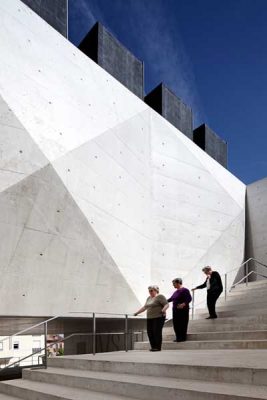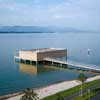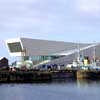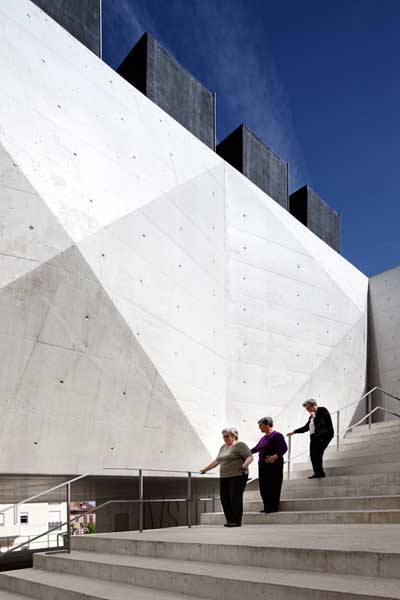Building Facades, Architectural Discussion, Article, Property Cladding Design
Architectural Facades
Architecture Cladding : discussion by Roland Wahlroos-Ritter
21 Jun 2011
Architecture Facades
Pragmatics Under the Skin
The completion of Herzog de Meuron‘s provocatively printed concrete skin for their library in Eberswalde in 1999 was a seminal moment for architects and designers, questioning Adolf Loos‘ dogma of the ornament as a crime. This culturally driven movement has recently gained momentum with a vastly expanded formal repertoire that new technologies have enabled us not only to explore, but also to build within reasonable budgets.
What may tie this week’s projects together is a careful consideration and design of the facade of the buildings as a complex set of parameters, as the interface between the interior and exterior, negotiating not only climate and its elements – rain, sun light etc. – but cultural values as well. However none of the envelopes of the following projects is ornamental or decorative by the whimsy of the designer, but deriving their beauty by the smart negotiation of environmental constraints and cultural parameters.
Law Courts in Gouveia, Portugal
Barbosa & Guimaraes

photo : FG + SG – Fotografia de Arquitectura
Barbosa & Guimaraes recently completed their new Law Court House in Gouveia, just two years after the completion of their spectacular first project, the Vodafone Building in Porto. The court house echoes the faceted facade language of the Vodafone Building but within a monolithic cuboid building volume, which is smartly situated to articulate a public plaza and re-define the urban space within which it is situated.
The levitating first floor reminds us of classics of the international style area and, with its austere white concrete appearance, signifies the authority and power of the court. At second glance however both the dictum of repetitiveness of international style and classical order of the court are cunningly undermined by a playful variation in the window apertures and facade facets. Whereas the facade of the first floor presents itself closed and inaccessible to the public, this relationship is subtly reversed through public access from the ground floor to the sunken and transparent courtyard and through a wide stair that spills out invitingly from the upper court floor.
Badehaus Am Kaiserstrand, Lochau, Austria
Lang+Schwärzler Architekturbüro

photograph : Bruno Klomfar
Lang+Schwärzler’s bath house as part of the Seehotel Am Kaiserstrand in Lochau, Austria presents itself similarly austere, but unlike the former is driven by more hedonistic motives. This monolith hovering above the waves of Lake Constance is articulated by a wooden slat fir skin, which resonates with the vernacular alpine architecture, boat houses and archetypical pile dwellings in Unteruhldingen. When opened, the skin’s shutters reveal the cafe behind and transform the monolith into a breathy, transparent structure allowing for unobstructed views from the cafe inside, onto the water outside.
Museum of Liverpool, England
3XN Architects – opening news

photo : Philip Handforth
The Museum of Liverpool by 3XN, is perhaps less characterized by its folded, rhomboidal metal facade, than by it’s bold sculptural appearance that crops out of an upwards folding motion of the surrounding landscape. The museum is strategically located at a nodal point of pedestrian traffic between Albert Dock and Pier Head and intelligently draws the public into the central atrium. The plucky sculptural gesture of the museum contrast sharply with the listed historic buildings behind. The skin with its gleaming metal aesthetic adds to the intriguing dialogue between historic and contemporary.
London Olympics Basketball Arena, UK
Wilkinson Eyre and KSS

photo from Olympic Delivery Authority
The completion of Wilkinson Eyre ’s Olympic Basketball Arena in London might be just another proof of the theory that more constraints lead to a better project. Designed as a temporary structure it was the fastest to get built, was on budget and its steel structure and membrane will be recycled after the games. The unassuming black interior, interspersed with orange seating to echo the color scheme of a basketball, is not only cost effective but allows the spectator to concentrate on what matters most, the game.
The building is clad in a captivating white PVC exterior. The intriguing aspect of this facade is that the geometry of the relief is less driven by ornamental or decorative desires, but rather by an intelligent dialogue between the materials and their constraints and the manipulations of the designers. Thus the membrane spanning over the steel structure generates a soft but surprisingly deep relief allowing for an intricate play of shadows on the facade, given the London weather allows for it.
US architect Roland Wahlroos-Ritter
Roland Wahlroos-Ritter is one of two Principals of WROAD. Recent design work includes the Bigger is Better House, an extended family residence in California, the Y-Project, a 17 level office high-rise in Seoul South Korea, Leg Avenue Office Extension in City of Industries California, Korean Embassy in Tokyo, Mason Residence in Santa Monica California and the experimental Wall Project in Los Angeles California.
He was a Assistant Professor at at the TU Vienna. In 2002, he was a Visiting Professor at the Cornell School of Architecture. After teaching at the Bartlett School of Architecture he taught at SCI-Arc until 2006 and is currently a Adjunct Assistant Professor at USC School of Architecture. Roland Wahlroos-Ritter is an SBA registered architect, and holds a license in The Netherlands.
Comments on this Architectural Facades article by US architect Roland Wahlroos-Ritter are welcome.
International Architectural Designs
Architecture Context : article by Trevor Tucker. Sep 2010
Architecture Narrative : article by Trevor Tucker. Aug 2010
Sustainable Architecture Design : article by Trevor Tucker. Aug 2009
Nature Architecture : article by Trevor Tucker. Sep 2009
Sustainable Buildings – Building Issues : article by Adrian Welch
Comments / photos for the Architecture Facades – Architectural Discussion Article page welcome






